We haven't found life on Mars yet. That's not too surprising, though disappointing. You can see its surface geology from orbit, plain to view, but any life is likely to be hidden inside rocks, under the soil or beneath the ice.
Pristine deposits of ancient life are likely to be buried meters below the surface, or recently exposed. Any organics left on the surface for long periods of time get destroyed by cosmic radiation and some other process, probably chemical.
The only way to find it is to use surface landers and rovers, but the search may well be a long one. Our rovers on Mars have explored only a few kms, of a planet with surface area similar to the entire land are of Earth. None of them could dig deep below the surface of the Martian soil, and only the two Viking landers in the 1970s, of all our missions to the planet, had the capability to search for life directly.
Our biological exploration of Mars has barely begun. So, how can a mission to Phobos help with this search?
First, let's look a bit more closely at why it is so hard to discover life on Mars itself.
GREAT CHANCE OF FINDING LIFE ON MARS
Curiosity has searched for traces of organics, but it didn't find anything until last autumn (see Martian freshwater lake may have supported life - NASA).
Curiosity continues to search for organics.
The search for ancient life is also likely to be a long one. Organics near the surface would get broken up over millennia, then after millions of years even the amino acids get broken up until there is hardly anything left. Then on top of that, some process seems to remove these organics, perhaps chemical. Meteorites should bring a constant steady flux of organics to Mars, and Curiosity should be able to detect this but didn't,
There are many things that can make preservation tricky just as for fossils on Earth. See this recent blog post Habitability, Taphonomy, and Curiosity's Hunt for Organic Carbon, by John Grotzinger, project scientist for the Curiosity mission
We may need to dig as much as ten meters below the surface to find organics, or hope for recently exposed outcrops. We may be in for a long search. However, Mars has great promise when we finally find what we are looking for.
As we continue to explore Mars, we have a great chance of discovering pristine samples from ancient Mars. It had no continental drift., The best evidence on Mars has probably been preserved at temperatures of tens of degrees below zero centigrade, untouched by water or micro-organisms, in a deep freeze for billions of years. It may be unchanged, in an exquisite state of preservation.
For this to work, the samples need to be buried quickly, meters below the surface. The materials must be right, clays or salts or sulfates, to preserve organics. It must have been left untouched, not weathered by later floods. In these ideal conditions, plunged into deep cold and protected from cosmic radiation, we might find perfect samples of early life, perhaps with its DNA or XNA intact, for us to study and sequence.
Our first pristine samples of organics from early Mars might come from layers buried by ejecta from a nearby meteorite impact or rapidly covered by the massive floods of early Mars. They could also come from deeply buried salt deposits in the ancient ocean beds of Mars. However, it may be some time before we find the right places to search for these deposits, and have the technology to dig deep enough to find the samples we are looking for. The ESA Exomars for instance can dig 2 meters - this is deep enough so that if it digs in the right place, it might find samples that are less damaged than surface samples - but is not deep enough to find completely undamaged ancient organics. Or if we are very lucky we might find ancient deposits, buried deeply long ago, but excavated again by a recent impact.
Artist's impression of ExoMars drilling 2 meters below the surface (credit ESA) - see Exomars drill for more about it.
A drill depth of 2 meters is a major advance over all previous rovers. However this is not quite enough to reach the depth necessary for totally pristine organics, at about 10 meters depth. Organics within a couple of meters of the surface, though better preserved than surface organics, get degraded over millions of years by cosmic radiation.
In the future we should be able to send automated moles able to dig kilometers below the surface. (There are possibilities for deep subsurface life also - conditions a few kilometers deep may be ideal for life at temperatures and pressures that permit liquid water).
Our search for life on the surface is likely to be a long one.
SAMPLE RETURNS FROM THE MARS SURFACE
You might think we could answer this quickly with a sample return from the Mars surface. This would work for Earth, a sample from almost anywhere on the Earth's surface would return microbial life. But Mars is far more inhospitable.
We need to search for rare potentially habitable areas of Mars for present day life. We need to find exactly right place to dig deep to search for past life.
So for instance, models based on the Phoenix observations can form cold liquid brines in Mars conditions easily enough. But most are too concentrated for life, the "water activity" levels are low. This depends on the mix of chlorides, sulfates and perchlorates in the sample. So even though those salts are common, it might well be that the right mixtures of salts for liquid with water activity levels suitable for life occur in just a few patches here and there over the surface of Mars.
Also, though on Earth any habitable region is quickly colonized; it is not so easy for life to spread on Mars. So, if there is life there today, not all the habitable regions may be inhabited. The same could be true of past habitats with life in them as well.
Mars was habitable for life for a brief few hundred million years only, with sunlight at levels half that for Earth. It wasn't habitable for long enough to build up thick deposits of organics. We know that because if Mars had deposits like that, oily shales for instance, they should be easy to spot, even from orbit. We would have found them by now.
Fossils in oily shales. If Mars had abundant layers of life like this, then we would have spotted them by now, easily.
So, it seems that past life on Mars must have been sparse as well. That should be no great surprise actually, as Mars didn't have long to get started, on a geological timescale. There are many things that could make ancient life on Mars hard to find.
Perhaps any life on Mars didn't arise until the end of the time of oceans (Noachian period), and needed all of those hundreds of millions of years to develop. Perhaps it evolved later, during the period of floods (Hesperian period), late in the Martian history. The floods could have created the conditions needed for evolution. Or perhaps life did arise almost straight away in early Mars, as soon as the first oceans formed; but then with the low light levels of Mars, a few hundred million years may not be long enough to build up thick deposits.
Perhaps early life on Mars could only survive in special locations such as sea shores, or fumeroles on land, or geothermal vents in the seas. Or perhaps life in its modern form didn't arise at all on early Mars.
The traces we look for might be of precursors of life, protobionts, or forms that reproduced, but only imperfectly, and easily damaged, not reaching the robustness and accuracy of present day life. Or they might be remains of a soup of chemical replicants without any separate cells as yet (RNA world or PNA world) - or we might find cell like structures, but without the chemistry of life to reproduce exactly.
Though not yet life in the modern sense, these primitive precursors could be of immense value for understanding the processes of evolution - on Earth all we have from this time are some zircons, diamond like stones, less than a mm across. At the least surely we will find protobionts on Mars, cell like structures, since they are created easily in simulations of early Earth.
Jack Hills rocks in Australia - tiny sub millimeter scale Zircons within these rocks are the only direct evidence we have of the earliest era of Earth
This era includes the entire story of evolution to the smallest known modern cells, far too complex to be the original lifeforms on Earth. On Earth we have almost nothing left from this time because of continental drift and the oceans and weathering. On Mars, without continental drift, with far colder conditions, we expect to find organic remains of tremendous value in unraveling the complex history of life - whether or not life did eventually evolve on Mars.
There could be many explanations, but one thing is clear. The evidence we have so far suggests that Mars probably never had abundant life for long enough to build up organics rich thick geological deposits such as the oil shales you find on ancient Earth.
PLANS TO RETURN A SAMPLE FROM THE SURFACE OF MARS - AND WHY THESE MAY NOT TELL US MUCH ABOUT LIFE THERE
Planetary geologists and space scientists are keen to return a sample from the Mars surface. Indeed this continues to be NASA's top objective for unmanned exploration of the solar system, not just for this decade, but the next decade also. The ESA also have ambitions to return a sample from the Mars surface.
Artist impression of an idea for a sample return by ESA from Mars (NASA have similar plans) - these missions are favoured by planetary scientists and geologists - but many exobiologists think that they are unlikely to return samples more conclusive for exobiology than the Martian meteorites we have already.
However, exobiologists who looked into this concluded that by far the best way to search for life on Mars is to send miniaturized biological instruments on our rovers to search for it actively on the surface first. That's mainly because of the difficulty of finding a suitable sample to return.
Samples from the surface are likely to have deteriorated due to cosmic radiation and chemical weathering. If organics are found, these might be from meteorites rather than ancient samples. And present day life is likely to be so sparse that even when you go to a suitable habitat, it may take some time to find it. It might only grow in some of the locations suitable for it (because it may be hard for life to transfer from one habitat to another in the harsh conditions of Mars). Also it may occur in a patchy way at low population densities in favourable habitats.
Many tools have been developed for in situ exploration of Mars surface for biosignatures. The first of these to fly to Mars since Viking will go on ExoMars in 2018. Other instruments that can be sent include SETG a DNA analyser, and a miniaturized scanning electron microscope under development (see Could there be Venus Cloud Microbes - Including XNA - And do Venus or Earth need Protection? for more about these with images and links).
If we return a sample from Mars at this stage, at great expense, it is likely to be no more conclusive for the biological exploration of Mars than the Martian meteorites we already have. Though the main motivation given for a Mars sample return is biological; if you look at the idea in detail, you find that it is likely to be only of great interest to planetary geologists.
HOW COULD MARS' INNER MOON PHOBOS HELP?
Might Mars' mysterious inner moon Phobos hold the answers to some of our questions? This is a far lower cost mission than a Mars sample return. It doesn't need to be a flagship mission diverting the lions share of the funding for NASA for unmanned exploration for two decades. Instead we could continue to explore the surface with biological instruments.
At first sight it might seem an unlikely place to look for life. It has been exposed to cosmic radiation, like the Mars surface, has no atmosphere or moisture, and could not support reproducing life - to our knowledge anyway.
Animation of Phobos rotating - full 360 degrees View, Credit ESA
(more Phobos and Deimos animations - APOD Phobos animation post)
Some of the features on Phobos may be caused by meteorite impacts on the surface of Mars sending debris into orbit which then hit Phobos. A recent study showed that perhaps 0.025% of the material in the Phobos regolith might be Martian in origin, some of it from the earl solar system. There is also a chance of larger meteorite fragments from Mars, in similar numbers to lunar meteorites on Earth. (Original paper: Mars impact ejecta in the regolith of Phobos: Bulk concentration and distribution)
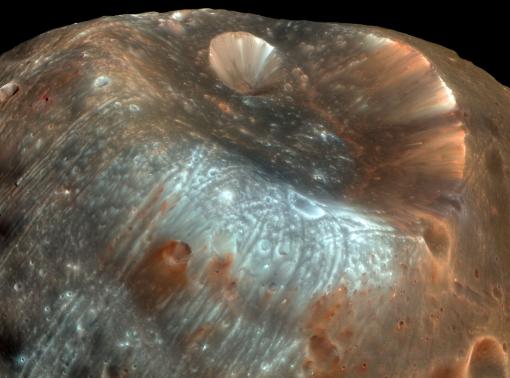
. A sample-return mission to Phobos would return material both from Phobos and from Mars.Credit: NASA
The interesting question is, could meteorites have impacted into habitable regions of Mars and sent materials to Phobos?
We have Martian meteorites on Earth, but these all come from recent impacts on Mars, within the last few tens of millions of years. After an impact on Mars, the debris from the impact eventually hits the inner planets or the sun, over a period of millions of years, and gets completely removed within a few tens of millions of years. So though we have evidence of ancient rocks on Mars in our samples, these are all from recent impacts within the last 40 million years- the ancient rocks were excavated from Mars relatively recently. Meteorites that hit Mars billions of years ago sent ejecta to Earth as well, of course - but those ancient Martian meteorites on Earth must have eroded away long ago - and would be hard to distinguish from other rocks here.
HOW MARTIAN SURFACE MATERIAL CAN GET TO PHOBOS
Ancient Martian ejecta on Phobos should still be there, intact, preserved for billions of years. There is no process to destroy it. It can only get hidden by the accumulation of later material on the surface. It would also be uncontaminated by Earth life. If we find amino acids or DNA, or other biosignatures in an ancient Martian meteorite on Earth then this is likely to be inconclusive. The same discovery in a Phobos sample would be clear evidence of life on Mars.
As it turns out, rather a lot of the Martian surface material can end up on Phobos after a meteorite impact.
Shows trasjectories of debris from an impact on Mars and the orbits of Mars's two moon's, Phobos (innermost moon) and Deimos
As reported by Purdue university in 2012, Evidence of life on Mars could come from Martian moon
"The team concluded that a 200-gram sample scooped from the surface of Phobos could contain, on average, about one-tenth of a milligram of Mars surface material launched in the past 10 million years and 50 billion individual particles from Mars. The same sample could contain as much as 50 milligrams of Mars surface material from the past 3.5 billion years.
"'The time frames are important because it is thought that after 10 million years of exposure to the high levels of radiation on Phobos, any biologically active material would be destroyed," Howell said. "Of course older Martian material would still be rich with information, but there would be much less concern about bringing a viable organism back to Earth and necessary quarantine measures.'"
The interesting thing about this is, that if there was life in the sample, still alive when the meteorite hit Mars, then it has not been exposed to whatever chemical processes erases the traces of organics on the surface of Mars. The material would just fly straight from Mars to Phobos, and then sit on Phobos relatively undisturbed from then on.
So, if life on the Mars surface was ever reasonably abundant in the past, then there may be traces of it on Phobos. Again, there might not be, if the life was in fragile habitats unlikely to reach Phobos as ejecta. It seems a possibility at least. Failure to detect life on Phobos doesn't mean that there was no life on Mars. But if life was abundant on Mars, in the past, then it might be easy to find it on Phobos, perhaps more easily tnan on the surface of Mars itself, at least in the early stages of exploration.
The surface area of Phobos is large, a fair amount of territory to explore, 1548.3 km2 (Same area as a square island 40 km by 40 km). Its surface is larger than Hong Kong or Singapore, and three times the size of the Isle of Man. If looking for larger meteorite fragments from Mars, we may need to explore Phobos also.
However the regolith is thought to contain many smaller particles from Mars also, and these are distributed throughout its surface. This suggests at least a possibility that any sample returned from Phobos could contain ancient Martian meteorite debris, and possibly also, evidence of ancient Mars life.
Ideally we could send rovers to Phobos to search the surface for traces of organics from Mars, using the ultra-sensitive detectors developed by exobiologists, and dig a little way beneath the surface to find older deposits, and perhaps, intact ancient meteorites of biological interest. Then we could return the most interesting samples for analysis on Earth.
We still have the process of cosmic radiation, to contend with which will destroy most of the organics over periods of many millions of years. Still there are signals, such as chirality,that could be preserved. Also there is no atmosphere to interact with the organics. Perhaps also we might find larger fragments buried deep enough below the surface to have some protection from the cosmic radiation.
It might be a bit of a long shot, because it would depend on the organics and life on Mars being sufficiently abundant. Certainly worth a try though.
Also, there is much else we can learn about Phobos from the mission.
OTHER THINGS WE COULD FIND FROM THE MISSION
Phobos's origins for instance are a mystery, it's hard to explain how it could enter its current orbit if it originated in the asteroid belt, but is not easy to explain as debris from a collision with early Mars either.
It would be great to resolve this mystery. Also either way, whether Phobos is made of materials from early Mars, or is an old asteroid from the asteroid belt, it is interesting to study it in detail for its own sake as well.
A mission to Mars could also access lower layers of Phobos by sampling the Stickney crater which dug deep below its surface.
This mission would also be useful as a way to assess the potential of Phobos for in site resource utilization for Mars orbital missions. Phobos might contain ice, which could be a major asset for future manned missions to Mars orbit,to explore Mars telerobotically, for rocket fuel or life support. See Phobos as first pit stop in manned Mars exploration.
EXPLORATION OF PHOBOS
There have been many plans to explore Phobos and return samples from it. One of them actually got as far as a launch, but its rocket failed soon after the launch, the failed Fobos-Grunt mission by Russia. This would have returned a sample from Phobos. The Russians still have plans to follow it up
The ESA is planning a mission for a sample return from Phobos in 2022 or later called PHOOTPRINT.
Phootprint (Artist impression, credit ESA)
For an overview of this mission as slides, see ExoMars - Mars Exploration Programs - and European Robotic Exploration Programme (EREP)
Another proposal is a mission under study by Stanford researchers, in collaboration with NASA, to send "hedgehog rovers" which would bounce over the surface of Phobos. This would study Phobos over a period of several years. It would be a technology demo for a system that could study other small bodies in the solar system in similar detail, and designed for high levels of autonomous operation.
Artist's impression of Fobos Grunt approaching Phobos
There have been several other proposals for missions to Phobos.
PLANETARY PROTECTION FOR SAMPLES RETURNED FROM PHOBOS
For the failed Fobos-Grunt sample return, Phobos was categorized as an "unrestricted category V". This means that no special precautions need to be taken. However there was some uncertainty about this categorization. So the Russians, planned to take precautions anyway, similar to those for a restricted category V return.
"Nevertheless, given the fact that the purpose of the mission is the delivery of soil from Phobos, a celestial body that is free of atmosphere and water, the developer of the spacecraft (Lavochkin Scientific and Production Association) with the Institute of Biomedical Sciences RAS, the status of the final phase of the mission was previously defined as a safe return to Earth of category 5 (“unrestricted Earth return”).
However, with allowance for some uncertainty in assigning the subcategory for this stage, and being aware of the responsibility for the safety of Earth, we have undertaken a number of measures (adopted by the representatives of COSPAR) to meet the requirements of planetary protection of Earth in delivering the samples
(1) Ensuring the integrity of the container with the Phobos samples at all stages of the mission until landing on Earth.
(2) Performing specific actions in Earth quarantine after delivering the Phobos samples to a special laboratory for studying the physical and chemical properties of the soil.
(3) Breaking the contact chain of Earth with the equipment delivered from Phobos by means of the following:a lander with the soil intake device (manipulators) is left on Phobos;the rocket delivering the landing module with the soil to Earth has no direct contact with the surface of Phobos, it being burnt in the Earth’s atmosphere, and its fragments exposed to natural sterilization; the outer surfaces of the module carrying a container with the soil are heated up to ~1500°C during free fall in the Earth’s atmosphere thereby providing for their natural sterilization.
For ensuring personal and public safety and protection of the environment, following the Federal law “On Sanitary and Epidemiological Welfare of 30.03.1999 no. 52FZ”, the medical and technical requirements have been developed for the organization, sanitation and epidemic prevention measures when working with the samples of Phobos soil and biological objects included in the experiment “BioPhobos” in a specialized laboratory (Institute for Medical and Biological Problems of Russian Academy of Sciences). Compliance with the requirements of Russian legislation is a priority for all types of work and mandatory for all organizations working with samples of Phobos soil and biological objects in the experiment “Bio Phobos”, regardless of the type and scale of the organization.
See Categorization of Phobos-Grunt, and for the details in the passage cited above, Realization of the COSPAR Planetary Protection Policy in the Phobos Grunt Mission
The risk of planetary protection for Phobos is far less than for the Mars surface because any sample has almost certainly been exposed to cosmic radiation for hundreds of thousands of years minimum. The most recently ejected Martian meteorite on Earth is EETA 79001 which was launched from Mars 600,000 years ago.
The EETA 79001 Meteorite, youngest meteorite from Mars, radiation exposure age 600,000 years. This is old enough so that it has been thoroughly sterilized by cosmic radiation during its journey to Earth. Many meteorite fragments from this same impact on Mars would reach Phobos after a much shorter journey (typically). However they would have rested on the surface of Phobos for a similar period of time, exposed to similar levels of cosmic radiation.,
(Incidentally, this meteorite is of historical interest as the one that was used to prove conclusively that the SNC meteorites were of Martian origin by measuring isotope ratios in trapped bubbles of gas in the Martian atmosphere).
Also theoretical studies suggest meteorites able to send materials to Earth would hit Mars once every one or two million years.
However it is possible that Phobos may have more recent samples of Mars than that. So, some planetary protection may be needed.
The chance of contamination from Phobos must be extremely low, but still, there is the remote chance of recent micro-organisms from Mars, and in the very remote chance that there is viable life in the sample, then there is a tiny chance of severe consequences as for any Mars sample return.
SUGGESTION TO STERILIZE THE SAMPLE FOR ADDITIONAL PROTECTION OF EARTH
The planetary protection guidelines for Mars sample return rely on a one in a million for a sample return to Earth.
In view of the severe consequences, of existential risk for humanity, even at exceedingly low probabilities, I wonder if we should go a bit further than the precautions suggested (for discussion)?
It would be almost impossible to protect against release of 0.01 micron scale GTAs or the possibility of tens of micron sized XNA based cells when the capsule is opened. However, you could make the chance of back contamination almost infinitesimal if you also sterilize the sample after return to Earth - or best of all - during the journey back
It would be a great shame to heat sterilize it. But you could submit it to passive sterilization using high energy ionizing radiation.
If you submit the entire sample to an equivalent level of radiation to a million years of cosmic radiation exposure - this would have no significant effect on ancient organics and even on recent organics of the last few million years. Yet it would sterilize any dormant life deposited in the last few millennia, in the remote chance that they exist. It would also do this non destructively, leaving remains easy enough to analyse to find out if there was viable recent life in the sample.
I suggest (for discussion) that we should also be totally sure of containment of the sample, and plan to break the chain of contact from the surface of Phobos to Earth, as was done for the failed Fobos-Grunt.
Despite the provisional classification as unrestricted Category V, following the Russians, I think it is reasonable to treat samples from Phobos as if they were restricted Category V. I suggest that we should treat them like that, until we have better understanding of conditions on Phobos, and how recent the deposits are from Martian impacts.
WHAT ARE THE CHANCES THIS WILL SUCCEED
The chance that we return evidence of ancient Martian life or recent life from Phobos may be low, but perhaps not impossible. However, it seems that the chance of returning present day or past life from the surface of Mars is also very low unless the sample isn't proved to have life in it already by detection of biosignatures.
Whether it has life or not, it should give us samples of ancient Mars as well as increase our knowledge of Phobos. So this interest in a sample return from Phobos is as a low cost sample return mission (compared with Mars) which probably has as good (or as bad) a chance as telling us something about ancient or present day life as a surface sample.
It's also a method that has less by way of issues of planetary protection than a sample return from the surface.
THE BEST WAY TO SEARCH FOR LIFE ON MARS
There is some chance of finding evidence of ancient life on Phobos I think, low but perhaps not zero.
However, the best way of finding evidence of life on Mars is to send instruments to the surface able to detect biosignatures directly, and to investigate a wide range of samples on the surface and drilled deep to ten meters below the surface.
And search the ocean shorelines and deltas, the warm seasonal flows, and geysers, and dune spots, and the subsurface soil in the upper lattitudes, and so on. And look in caves, and rivers and flood plains; and if we can find ancient hot spots, geothermal vent type habitats look there as well and so on.
Later we may return samples from those places also, but if so should proceed with great care. See my Need for Caution for an Early Mars Sample Return.
Maybe this idea to use ionizing radiation to sterilize the first sample returns in a non destructive way may help for Mars surface sample returns also. It's not used for spacecraft sterilization because it would damage the sensitive electronics. But for a sample return, if applied to the capsule only, that's not an issue.
SEE ALSO
For more about this see Need for Caution for an Early Mars Sample Return, especially the section on existential risk calculations.
Also my more recent Could there be Venus Cloud Microbes - Including XNA - And do Venus or Earth need Protection? goes into the XNA issues in more detail as well as issues for Gene Transfer Agents.



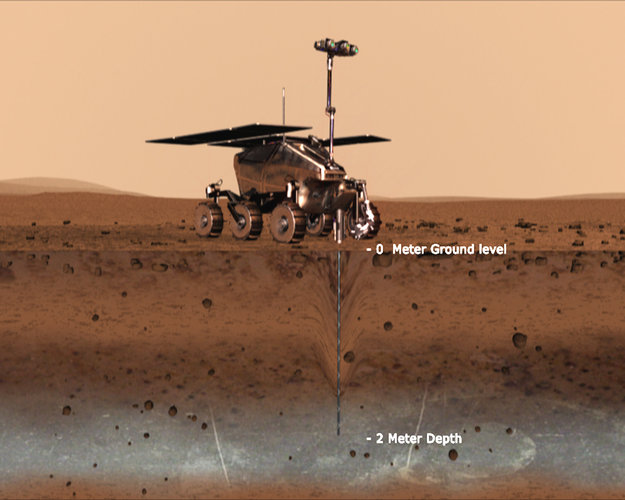
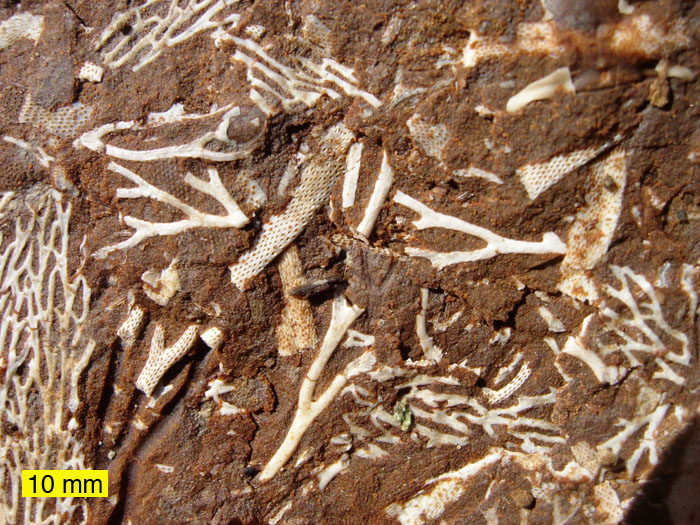

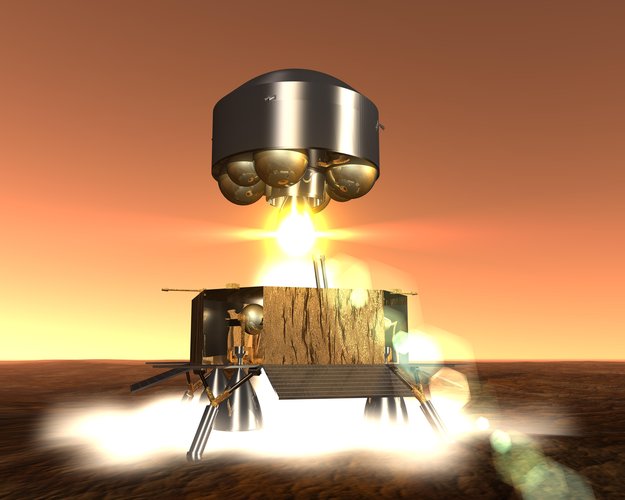
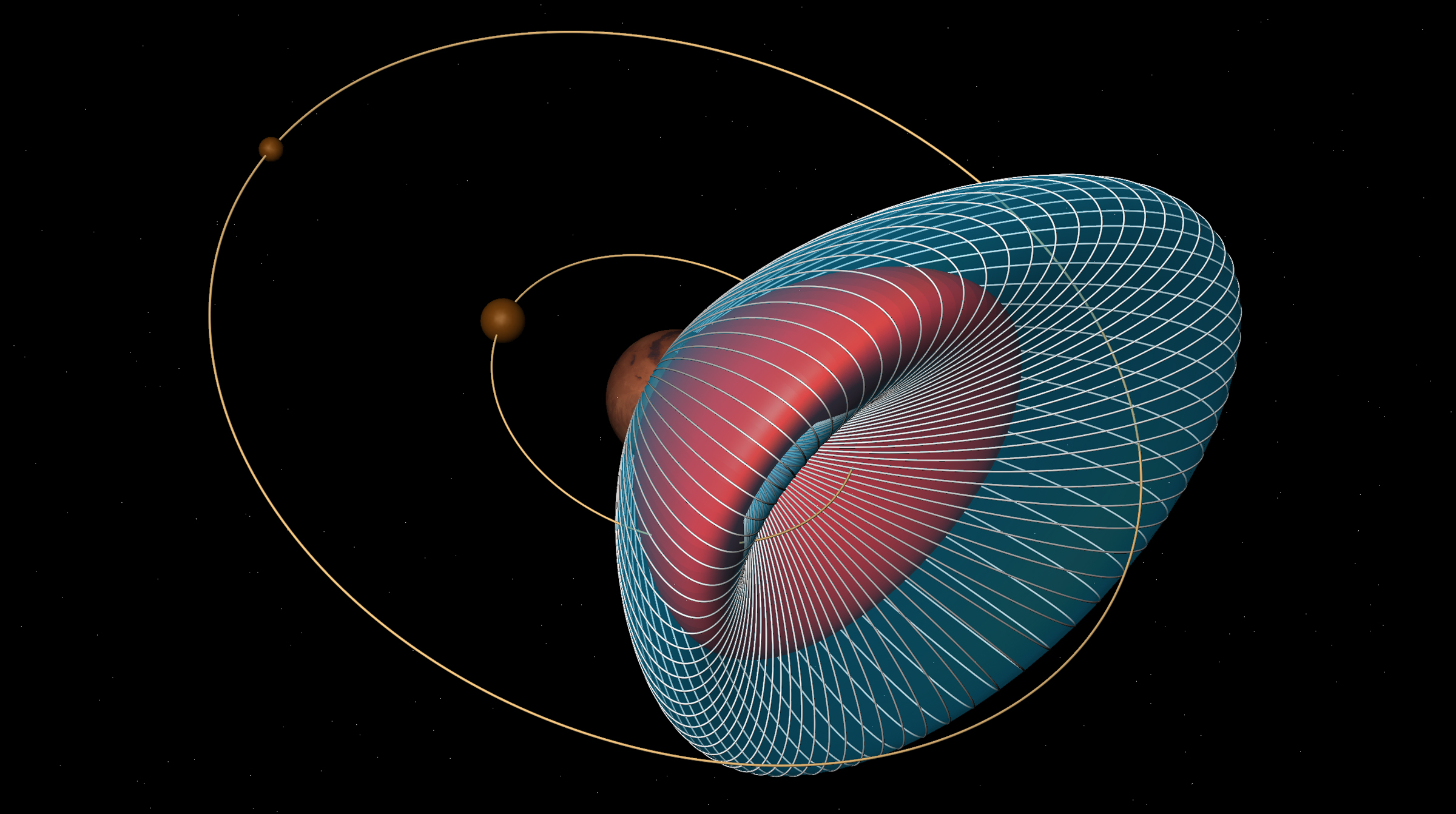
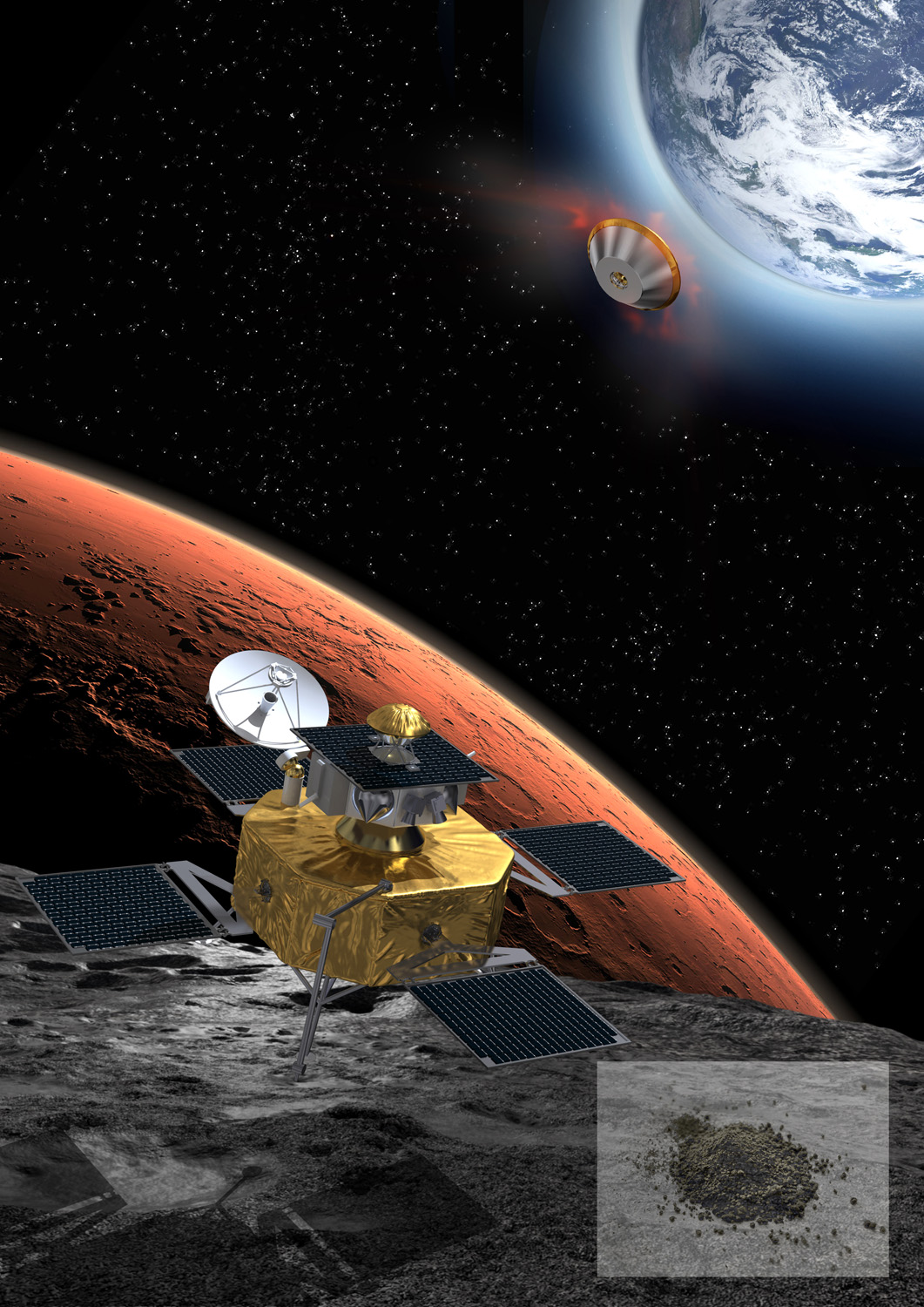





Comments